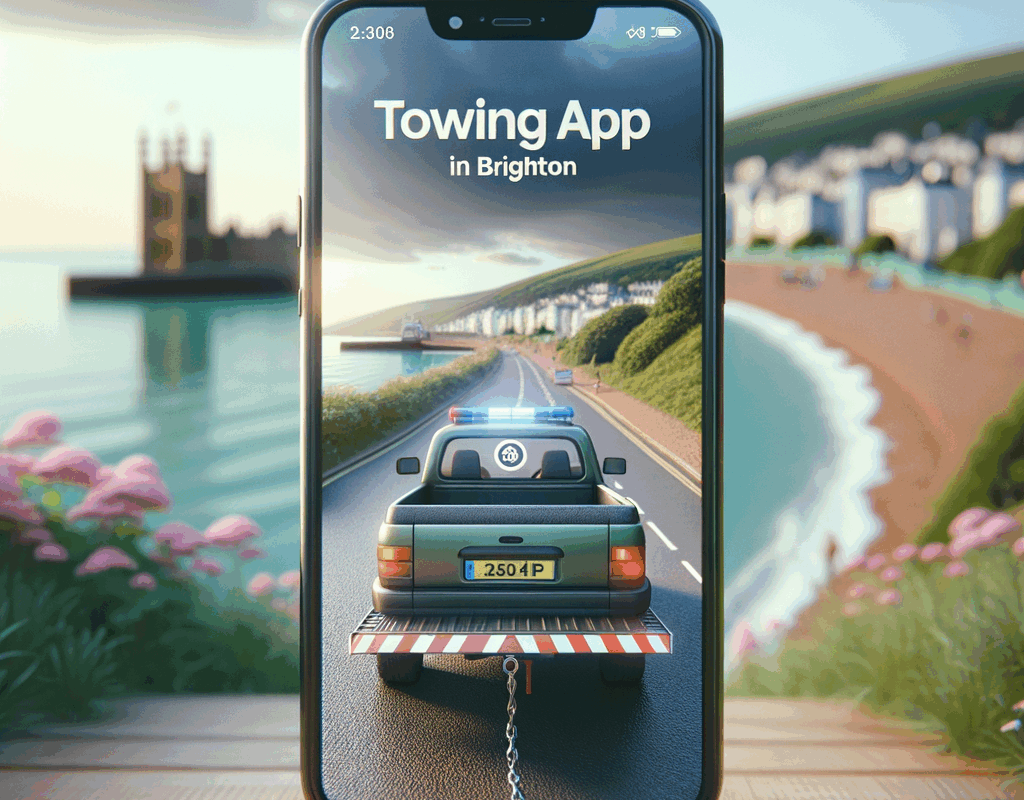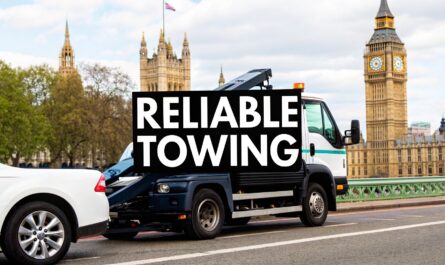Introduction
Stranded on the A23 or stuck by the seafront? A Towing App in Brighton can summon nearby recovery in minutes, not hours. With a few taps, you share your location, describe the issue, see an `ETA`, and track help as it arrives. In this guide, you’ll learn how these apps work, how to compare local and national providers, what affects price and response time, and exactly what to do to stay safe while you wait. You’ll also get practical tips, local examples, and common pitfalls to avoid.
How a Towing App in Brighton Works
Request help in minutes
– Open your app and allow location services. Confirm your spot on the map (A23, A27, A259, or a side street in Hove).
– Select the service: jump-start, tyre change, fuel delivery, `winch-out`, or full recovery.
– Add details: vehicle type, `VIN` if handy, and a short description (e.g., “flat battery, underground car park”).
– Get a driver match, transparent `ETA`, and live tracking until arrival.
Practical example: After a day at the beach, a motorist finds a dead battery near Madeira Drive. The app assigns a nearby patrol with a booster pack and provides a 22-minute `ETA`. The driver sees the patrol’s progress, receives a safety reminder, and is back on the road within 40 minutes.
Pricing models explained
Towing apps typically use:
– Distance-based pricing: base fee plus per-mile towing.
– Service-based pricing: fixed fees for jump-starts, tyre changes, or lockouts.
– Time-of-day adjustments: higher rates at night or during peak demand.
– Access surcharges: underground car parks or tight lanes may require extra time/equipment.
Cost varies by provider, vehicle, and location. You’ll often see an upfront estimate before you confirm, which helps avoid surprises.
Coverage hotspots in and around Brighton
– Major routes: A23 (London Road), A27 (east–west bypass), and A259 (coast road).
– Visitor areas: Brighton Pier, The Lanes, North Laine, Marina Village.
– Nearby towns: Hove, Portslade, Rottingdean, Shoreham-by-Sea.
Apps use `geofencing` to dispatch the closest available recovery truck.
> Important: If you break down on a motorway or fast A-road, follow National Highways guidance first. Use an emergency area or hard shoulder if available, exit the vehicle by the passenger side, and call 999 if you are in immediate danger. See the official breakdown advice from National Highways for full steps: motorway breakdown guidance.
Choosing the Towing App in Brighton That Fits You
National networks: AA, RAC, Green Flag
Large national providers operate across Sussex with robust app features:
– AA app: membership management, breakdown requests, and real-time updates. See the AA app features.
– RAC: well-known roadside patrols and digital tools for requests and tracking. Explore the RAC breakdown advice and services.
– Green Flag: networked recovery partners and an app to request assistance. Review the Green Flag app overview.
Pros:
– Broad coverage and consistent standards.
– Integrated membership benefits.
– Streamlined claims with insurers.
Cons:
– Membership plans may be required for best pricing.
– High demand can stretch response times during peak events.
Local independents in Brighton & Hove
Independent recovery firms often deliver quick, flexible service:
– Familiar with narrow streets, mews roads, and underground parking.
– Competitive rates for short-distance recoveries within the city.
– Direct communication with the driver.
Best practices to vet locals:
– Check `ETA` transparency and cancellation policies.
– Confirm equipment for your vehicle type (EV, AWD, motorbike).
– Review ratings within the app and look for consistent comments on punctuality and care.
Case study: A27 puncture vs. city-centre dead battery
– Scenario 1: A27 puncture at dusk. A national provider connects a patrol equipped for high-speed roadside work, with cones and safety lighting. The patrol completes a wheel swap, following National Highways protocols.
– Scenario 2: Dead battery in a tight North Laine car park. A local operator with a compact van navigates the low-clearance ramp, jump-starts the vehicle, and advises a 30-minute drive to recharge.
Takeaway: Match the provider to the environment—fast roads often favour national patrols; tight urban settings can reward local expertise.
Pros and cons at a glance
– National providers
– Pros: scale, standards, integrated benefits
– Cons: potential waits during peak demand
– Local independents
– Pros: city agility, flexible pricing, quick short-haul
– Cons: variable standards; verify insurance and equipment
Real Costs, ETAs, and What Affects Them in Brighton
What drives cost and response time
– Location: A23/A27 shoulder recoveries require additional safety procedures.
– Time of day: Late-night or early-morning jobs may incur surcharges.
– Vehicle type: EVs and AWDs may require flatbeds; motorbikes need wheel chocks.
– Situation complexity: `winch-out` from soft verge vs. simple jump-start.
– Events and traffic: Pride weekend, Brighton Marathon, or match days can extend `ETAs`.
Actionable tips:
1. Share precise location (junction numbers, nearby landmarks).
2. Add clear notes (wheel lock key location, tyre size, warning lights shown).
3. Keep your phone line open; answer calls from unknown numbers (dispatchers).
Seasonal and event-based spikes
– Summer weekends: Heavy visitor traffic along the seafront strains resources.
– Brighton Pride: Road closures and congestion impact access routes.
– Stormy weather: More `ETAs` slip when high winds or flooding affect the A27.
Strategy: If you anticipate a busy weekend trip, pre-verify your cover level and enable notifications in your app. Consider scheduling preventive checks to avoid avoidable breakdowns.
Data-driven insights you can use
Reliable sources consistently note common breakdown causes:
– Batteries: Flat or failing batteries top the list. See the RAC’s overview of frequent faults and prevention tips: common breakdown causes.
– Tyres: Punctures and sidewall damage from kerbs and debris.
– Fuel issues: Wrong fuel and empty tanks are still common.
– Alternator and starter faults: Often present as dim lights or clicking sounds.
Knowing the likely cause helps you choose the right service in the app, which speeds triage and reduces cost.
Safety, Speed, and Best Practices While You Wait
Step-by-step safety protocol
1. Move off the carriageway if possible; aim for a lay-by or safe side street.
2. Turn on hazard lights; wear a high-vis vest if available.
3. Exit via the passenger side; keep passengers behind barriers when on fast roads.
4. Position warning triangles where appropriate (not on motorways).
5. Use the app’s messaging to update your status safely, away from traffic.
Consult the official guidance for motorways and high-speed roads: National Highways breakdown guidance.
Share a pinpoint-accurate location
– Use the app map to drag the pin to your exact spot.
– Add landmarks: “Eastbound A27, 200m before Falmer exit” or “Marine Parade near the Zip.”
– Consider `what3words` if the app supports it.
– Send a safe photo of the surroundings to help the driver identify you quickly.
Common mistakes to avoid
– Vague requests: “Car won’t start” without context slows dispatch. Mention warning lights and recent symptoms.
– Hidden obstacles: Failing to note height restrictions or gated courtyards leads to delays.
– Drained phones: Keep a charger in your glovebox; low battery can break communication.
– Unsafe positioning: Never attempt roadside repairs on fast roads.
Documentation and insurance essentials
– Keep `VIN`, policy number, and preferred garage on hand.
– Photograph vehicle condition before loading onto the flatbed.
– Ask for a digital job card or receipt for claims.
– If you have breakdown cover via your bank or insurer, confirm call-out limits and excesses.
Optimizing Your Use of a Towing App in Brighton
Pre-trip checklist for fewer surprises
– Battery health: Short trips in winter drain batteries; take a longer drive weekly.
– Tyres: Check tread and pressure, especially before A27/A23 runs.
– Fluids: Oil, coolant, washer fluid.
– Essentials: High-vis vest, triangle (not for motorways), phone charger, torch.
For a detailed prep routine, see our roadside assistance checklist.
Roadside fix or full recovery?
– Choose roadside help for: jump-starts, tyre swaps, simple fuel misfuels.
– Choose tow/recovery for: drivetrain faults, overheats, severe punctures, or EV transport.
– EV note: Ask for a flatbed; many EVs should not be towed with wheels on the ground.
Business and fleet tips
– Centralize: Use one account to manage multiple vehicles and drivers.
– Data: Review response times and incident types quarterly to reduce repeat issues.
– Locations: Pre-authorize drop sites (depots, preferred garages) to shorten handling time.
Privacy and data basics
– Review permissions: Location sharing is essential for accurate dispatch.
– Secure data: Use strong passwords and enable multi-factor authentication if available.
– Delete old vehicles you no longer own from your profile.
For more selection advice, read our guide to choosing a towing company.
Conclusion
A Towing App in Brighton can turn a stressful roadside breakdown into a managed, trackable experience—with transparent `ETAs`, clear pricing, and safer protocols. Choose between national networks for scale or local independents for city agility, and use the tips above to cut costs and time. Ready to be prepared? Install and set up your preferred app today, save your vehicle details, and store a charger in your car. The next time you need help, the Towing App in Brighton will be one tap away—what steps will you take now to be road-ready?
FAQ
Q: How fast can a towing app reach me in Brighton?
A: It varies by time, location, and demand. You’ll see a live `ETA` after you submit details in the app.
Q: Do I need a membership for help?
A: Not always. Some apps offer pay-as-you-go alongside membership plans. Check fees before confirming.
Q: Can an app handle breakdowns on the A27 or A23?
A: Yes. Use the app for dispatch, then follow National Highways safety guidance while you wait.
Q: What information should I provide?
A: Exact location, vehicle type, visible issues, access limits (height/width), and preferred drop-off.
Q: Are EVs handled differently?
A: Often yes. Request a flatbed and note your make/model so the dispatcher sends suitable equipment.





